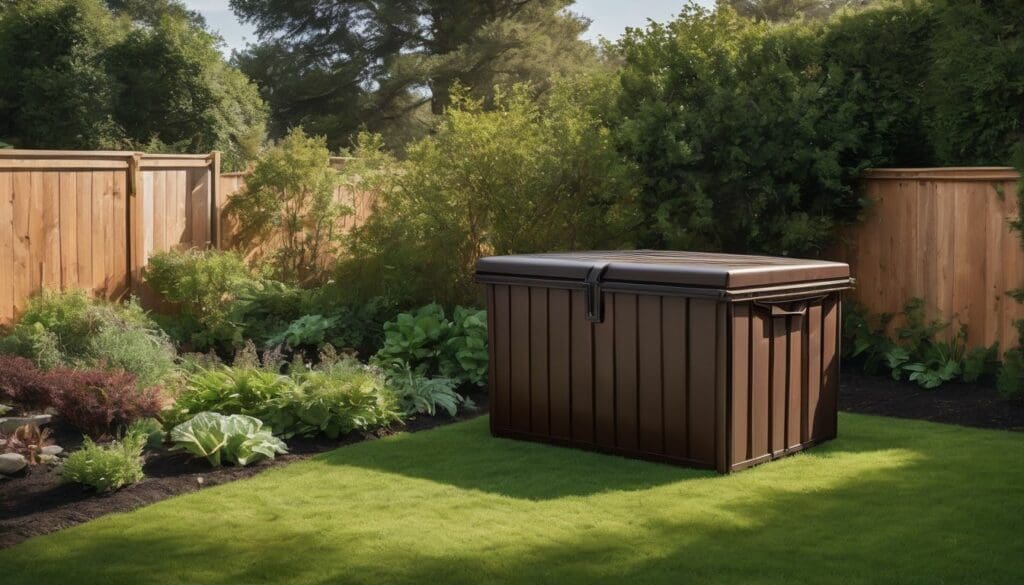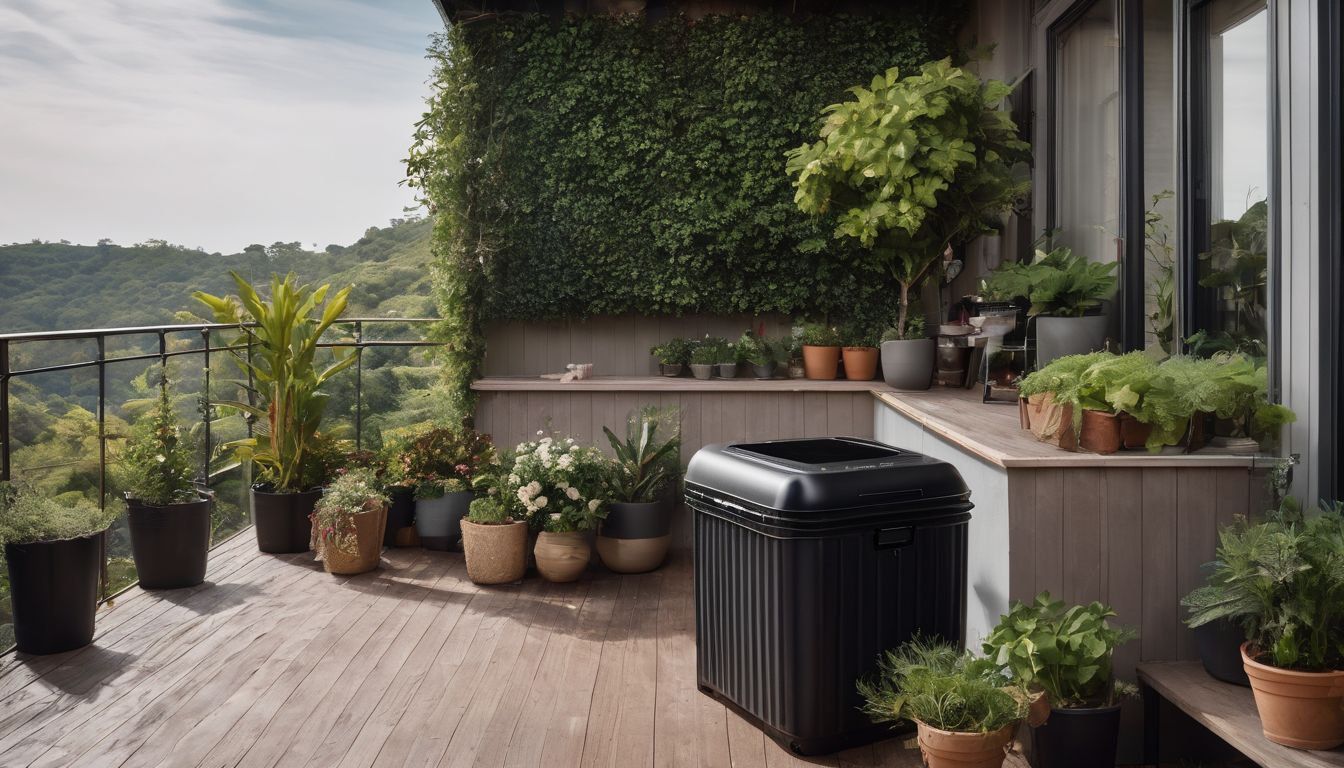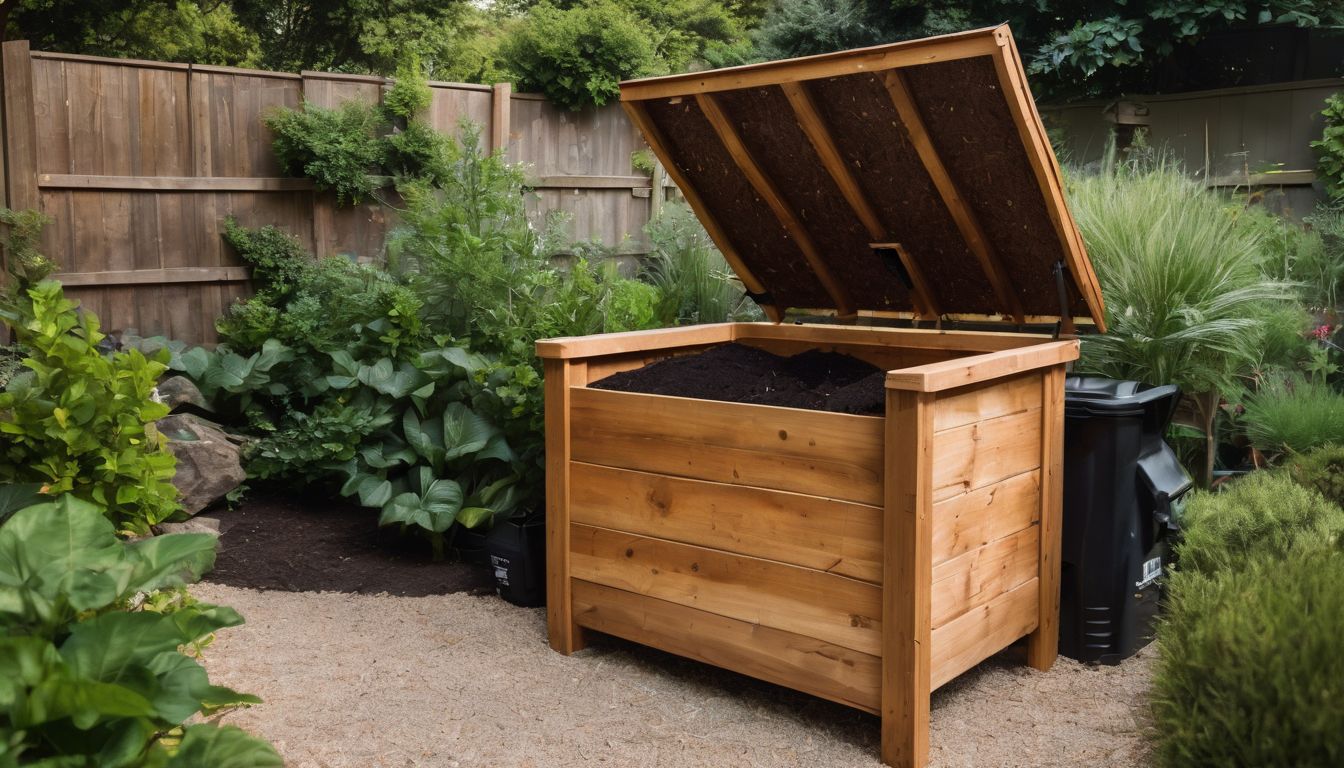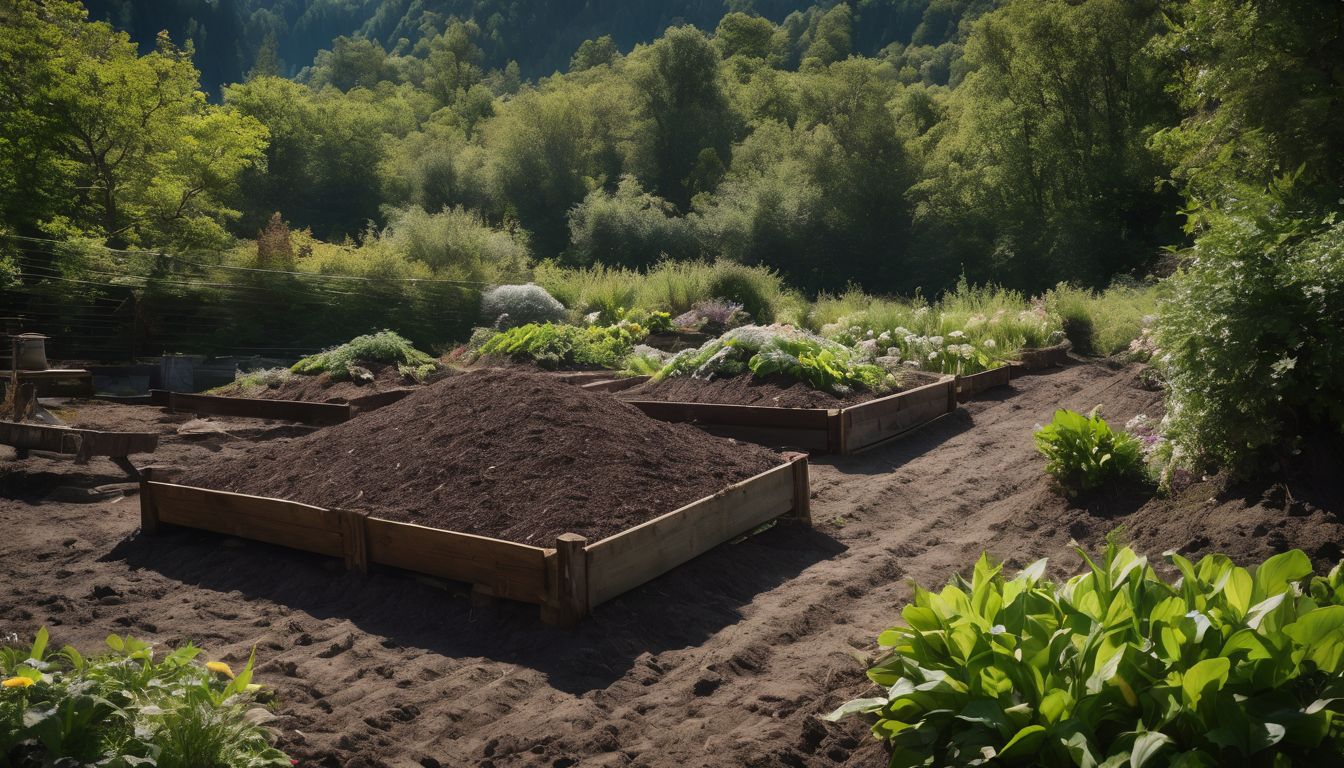Creating the perfect compost mix might feel like a tricky quest, especially for those new to gardening or looking to reduce household waste. Did you know that maintaining a balance between green and brown materials is key to successful composting? Our guide will lead you through simple steps to transform your kitchen scraps and garden waste into nutrient-rich food for your plants.
Dive in and let’s turn waste into wonder!
Key Takeaways
- For a well – balanced compost mix, aim for a mix of 2 parts green materials like fruit scraps to 1 part brown materials such as dried leaves.
- Regular watering and turning of the compost pile are necessary actions to encourage proper decomposition and prevent bad odours.
- Composting not only improves soil quality for plants but also supports environmental conservation by reducing landfill waste.
- Avoid adding meat, dairy, diseased plants, weeds with seeds, pet waste, glossy paper or chemicals to your compost pile to keep it healthy and productive.
- Utilise multiple compost piles at different stages of decomposition to ensure a continuous supply of mature compost throughout the year.
Understanding the Basics of Composting
Composting is the process of breaking down organic waste into nutrient-rich soil. It benefits the environment by reducing landfill waste and greenhouse gas emissions. There are different types of composting, such as vermicomposting and hot composting, each with their own benefits and methods.
What is composting?
Composting transforms organic waste like vegetable peelings, yard clippings and fruit scraps into nutrient-rich soil. It’s a natural process where microorganisms break down this material under aerobic conditions, creating a fertile mix that can help plants grow.
Think of it as Mother Nature’s way of recycling—turning what we don’t need into something our gardens love.
By carefully combining green materials full of nitrogen with brown ones rich in carbon, you foster the right environment for microbial activity. This activity heats up the compost pile, speeding up decomposition.
The result? A valuable amendment that enhances soil health without relying on chemical fertilisers.
Benefits of composting
Composting enriches soil, reduces waste, and decreases the need for chemical fertilisers. It also helps in reducing methane emissions from landfills.
- Organic Waste Recycling
- Composting allows organic waste to be recycled into nutrient – rich soil conditioner.
- Nutrient – Rich Potting Soil
- Compost adds essential nutrients to the soil for healthier plant growth.
- Environmental Conservation
- By composting organic matter, you contribute to a sustainable environment by reducing landfill waste and methane emissions.
- Sustainable Living
- Embracing composting supports a sustainable lifestyle and minimises your carbon footprint.
- Plant Nutrition
- Nutrient – rich compost boosts plant health and resilience, benefitting the entire ecosystem.
Different types of composting
Composting techniques vary according to the method used.
- Traditional composting involves piling organic materials together and allowing them to decompose over time.
- Vermicomposting utilises worms to break down organic waste into nutrient-rich compost.
- Hot composting requires higher temperatures to speed up the decomposition process.
- Bokashi composting ferments organic waste using beneficial microorganisms in an airtight container, producing a nutrient-rich soil amendment.
Materials for Composting
Green materials, such as fruit and vegetable scraps, grass clippings, and coffee grounds, provide nitrogen to the compost mix. Brown materials like dried leaves, straw, and newspaper add carbon.
A pitchfork or shovel is necessary for turning the pile regularly to aerate it and speed up decomposition.
Green materials
Green materials are essential components of a balanced compost mix, providing nitrogen and moisture to the pile. They accelerate the decomposition process and contribute to the nutrient content. Incorporate these green materials into your compost mix:
- Grass clippings: Add a layer of grass clippings, ensuring they are free from pesticides.
- Vegetable and fruit scraps: Include kitchen scraps such as peelings, cores, and spoiled produce.
- Coffee grounds: Utilise used coffee grounds for their high nitrogen content.
- Plant trimmings: Incorporate pruned leaves and small branches for additional green matter.
- Seaweed: If available, add seaweed to provide minerals and nutrients.
Brown materials
To create a balanced compost mix, incorporating brown materials is crucial. They provide carbon for the compost pile and help balance the nitrogen-rich green materials. Here are essential brown materials for your compost mix:
- Dry leaves: Collect fallen leaves in autumn to add as a carbon-rich layer to your compost.
- Straw or hay: These materials add structure and air space to the compost pile, aiding decomposition.
- Newspaper or cardboard: Shred or tear them into small pieces to enhance aeration in the compost.
- Sawdust or wood shavings: These materials break down slowly, adding slow-release nutrients to the compost mix.
- Corn stalks or husks: Chop them into small pieces before adding them to the compost pile for extra carbon content.
- Pine needles: They are an excellent source of acidity in the compost and add diversity to the material mix.
- Shredded paper bags: Repurpose paper bags by shredding them and including them in your compost for added carbon.
Equipment/tools needed
When creating a balanced compost mix, the following equipment and tools are essential:
- Compost bin or container: Use a sturdy, well-ventilated container to hold the compost materials.
- Aerator or turning tool: This helps in regularly turning the compost pile to ensure proper aeration and decomposition.
- Pitchfork or shovel: These are necessary for mixing and aerating the compost materials.
- Watering can or hose with a gentle spray nozzle: It is important to keep the compost pile adequately moist, so a watering can or hose with a gentle spray nozzle will help achieve this.
- Thermometer: A thermometer will assist in monitoring the internal temperature of the compost pile, ensuring ideal conditions for decomposition.
Building the Perfect Compost Pile
Achieving the ideal balance of green and brown materials, proper watering and regular turning are essential for creating nutrient-rich compost – read on to learn how to build the perfect compost pile.
Ideal ratios for greens and browns
To create nutrient-rich compost, aim for a mix of approximately 2 parts green materials to 1 part brown materials. Green materials are high in nitrogen and include items like fruit and vegetable scraps, grass clippings, and coffee grounds.
Brown materials are high in carbon and consist of items such as dried leaves, straw, and shredded paper. By maintaining this balance, you’ll provide the microorganisms in your compost pile with the optimal conditions for breaking down organic matter effectively.
To achieve a well-balanced compost mix that decomposes efficiently while retaining essential nutrients, strive for an adequate ratio of greens to browns. This will result in nutrient-rich compost that is beneficial for plant nutrition and overall soil health.
Proper watering
When creating a compost pile, it is essential to maintain proper moisture levels. This involves ensuring that the compost materials are damp but not waterlogged. Moisture content contributes to the breakdown of organic matter.
Regularly check the compost pile for moisture and adjust by adding water as needed, aiming for a consistency similar to a wrung-out sponge.
Consistent watering helps promote microbial activity and decomposition within the compost heap, enriching it with valuable nutrients. Adequate moisture also supports the overall health of the compost mix and ensures that beneficial organisms thrive in its environment.
Regular turning
After ensuring proper watering, regular turning of the compost pile is essential to aerate the materials. This process helps in breaking down the organic matter efficiently and prevents foul odors from developing.
Turning also allows for even distribution of moisture and air, promoting an ideal environment for beneficial microorganisms to thrive.
By turning your compost regularly, you accelerate the decomposition process and ultimately create a nutrient-rich mix. It’s recommended to turn the pile every one to two weeks using a pitchfork or shovel.
Importance of multiple piles
To create nutrient-rich compost, multiple piles are essential. This allows for a continuous rotation of materials and ensures a steady supply of finished compost. By having multiple piles at different stages – one actively being filled, one in the process of decomposition, and another ready for use – you can maintain a consistent supply of compost throughout the year.
This approach also helps to manage organic waste efficiently, promoting sustainability within your gardening efforts.
Furthermore, having multiple piles allows for better control over the composting process. Different materials have varying decomposition rates, which can be managed more effectively when separated into distinct piles.
Using Your Compost
Incorporate your nutrient-rich compost into your gardening routine to improve soil health and plant nutrition. Remember to avoid putting certain items in your compost, but also make use of compost tea and potting soil for optimal results.
How to incorporate compost into your gardening routine
To incorporate compost into your gardening routine, follow these simple steps:
- Spread a layer of compost over the soil in your garden beds to improve its fertility and structure.
- Mix compost into the soil when transplanting or planting new seeds to provide essential nutrients for plant growth.
- Use compost as a top dressing around existing plants to promote healthy root development and increase water retention.
- Create a compost tea by steeping compost in water and use it as a natural fertiliser for your plants.
- Avoid using compost on plants that are sensitive to high nutrient levels like succulents or cacti.
What not to put in compost
Avoid adding meat or dairy products as they can attract pests. Also, refrain from including diseased plants or weeds with mature seeds that can survive composting. Additionally, avoid adding pet waste, glossy paper, and items treated with chemicals such as pesticides. Furthermore, do not include oily or greasy materials, and steer clear of using coal or charcoal ash in your compost mix. Lastly, refrain from adding any non-biodegradable materials, plastics, or synthetic fibers to your compost pile.
Compost tea
After learning about what not to put in compost, it’s time to explore another valuable aspect of composting – compost tea. This nutrient-rich liquid fertiliser is created by steeping finished compost in water and can be used to boost plant health and growth.
To make compost tea at home, simply add a shovel full of your matured compost into a porous bag or old stocking, submerge it in water inside a bucket or large container, and let it brew for 24-48 hours while occasionally stirring.
The resulting brew can then be poured directly onto the soil around plants as a natural plant food.
Using compost as potting soil
When using compost as potting soil, ensure the mix is well-balanced to provide proper nutrients for your plants. Mix compost with equal parts of sand or perlite and topsoil to create a nutrient-rich blend that promotes healthy growth.
This DIY method not only supports environmentally conscious living but also reduces waste by reusing organic materials from your compost pile. Once incorporated into your gardening routine, this nutrient-rich compost mix can enhance plant nutrition and support sustainable living practices.
Transforming kitchen scraps and garden waste into potting soil contributes to green waste reduction while promoting conservation efforts. Creating a balanced compost mix ensures that you maximise the benefits for your plants while positively impacting the environment through recycling efforts.
Tips for Creating a Climate-Positive Compost Mix
Make a pledge for sustainable living by committing to composting and recycling efforts. Utilise fallen leaves as a free resource for creating nutrient-rich compost.
Making a pledge for sustainable living
Committing to sustainable living practices is a crucial step towards reducing our environmental impact. By pledging to recycle, compost, and reduce waste, we actively contribute to a healthier planet for future generations.
Choosing eco-friendly products and supporting local and organic resources also play an essential role in creating a more sustainable lifestyle. Embracing these changes empowers individuals to take positive steps towards mitigating climate change and preserving natural resources.
Taking responsibility for our actions by adopting sustainable habits is key to making a significant difference in the fight against environmental degradation. Incorporating simple yet impactful changes into daily routines can lead to meaningful long-term benefits for both the environment and overall well-being.
Combining recycling and composting efforts
Combining recycling and composting efforts is a powerful way to reduce waste and lower your environmental impact. By diverting organic waste from landfills through composting, you can create valuable nutrients for your garden while also reducing greenhouse gas emissions.
Additionally, recycling materials such as paper, plastic, glass, and metal helps conserve resources and minimise the energy-intensive process of manufacturing new products.
By combining these two initiatives, you can actively contribute to creating a more sustainable environment while also benefiting from nutrient-rich compost to support healthy plant growth.
Making a conscious effort to recycle and compost not only reduces the amount of biodegradable waste in landfills but also minimises the need for chemical fertilisers that have negative impacts on soil health and water systems.
Utilising fallen leaves
Fallen leaves are a valuable resource for creating nutrient-rich compost. Shredding the leaves before adding them to your compost pile accelerates the decomposition process. Mix the shredded leaves with green materials to balance the carbon-to-nitrogen ratio and enhance microbial activity, resulting in high-quality compost.
By utilising fallen leaves in your compost mix, you contribute to reducing waste while enriching your soil naturally. This sustainable practice not only benefits your garden but also supports environmental conservation efforts.
Conclusion.
In conclusion, creating a balanced compost mix is essential for nutrient-rich soil. Mixing green and brown materials in the right ratios is key. Regularly turning and watering the pile are important steps to ensure effective decomposition.
Incorporating compost into your gardening routine contributes to sustainable living practices while benefiting your plants’ nutrition.
FAQs
1. Why is it important to have a nutrient balance in my compost mix?
A balanced mix of nutrients in your compost is key for plant nutrition, ensuring your plants grow healthy and strong.
2. What are green and brown materials in composting?
Green materials for compost add moisture and nitrogen, while brown materials provide carbon; both are essential for creating a nutritious compost mix.
3. Can I make compost at home using DIY techniques?
Absolutely! You can make nutrient-rich compost at home by following simple steps that include layering green and brown materials, turning the pile, and maintaining proper moisture levels.
4. How does making my own compost contribute to sustainable living?
By creating your own balanced compost mix through DIY methods, you reduce waste and enrich soil health without relying on chemical fertilisers, which supports sustainable living practices.





